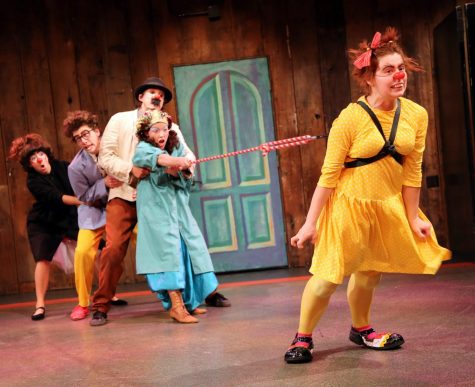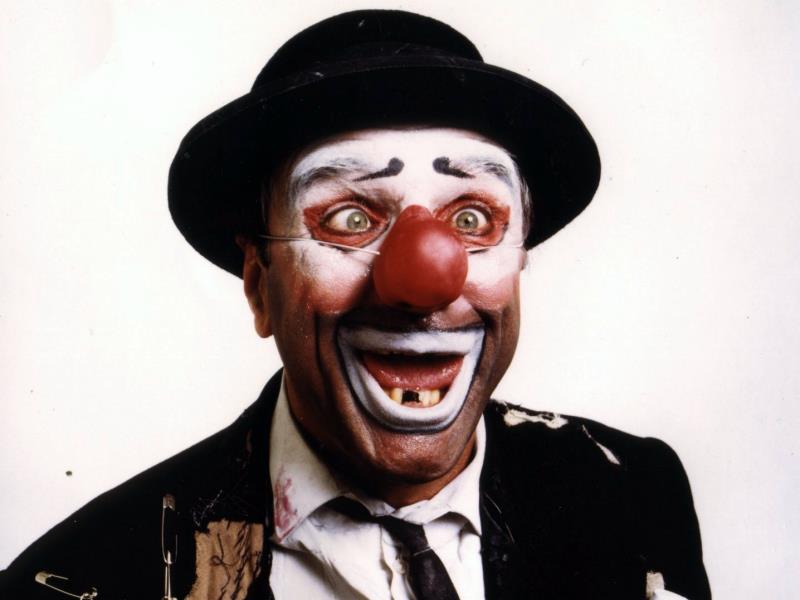The Way of the Clown
Often misunderstood, clowns offer an alternative viewpoint
DISCLAIMER: Writing about comedy is never funny. As the old saw goes, “you can dissect a frog, but you wind up killing it in the process.”
I was going about my business in Madrid, playing jazz gigs and teaching in the early 90s, when I got a call from the notorious clown Jango Edwards who needed a pianist for some shows. It was a total surprise; I knew who he was from my years in Amsterdam, where he was a legend. I had seen a couple of his shows and had a couple of buddies that played in his band. One of them had played him a few of my wackier demos, which led him to contact me. We made the arrangements to meet in Switzerland for the gigs.
He sent me a videocassette of one of his performances to learn the pieces and I met him some weeks later at a casino in Zurich at the soundcheck an hour before the first show. I asked him if we could run over some of the cues, especially for his convoluted pet piece “The Weezer,” and he said, “Nah, I don’t rehearse. What I want to know is what are you going to do to fill the five minutes that it takes me to go backstage and change into my fat suit?”
Unaware I was supposed to do a comedy routine, I was caught short. I had nothing prepared and started to sweat bullets. I had worked with other comedy and theater groups but my place was usually behind the piano; I was thoroughly petrified to leave that security to step up to the microphone at center stage where the spotlights blazed and everyone would be staring at me. The first night I stayed at the piano playing tunes during those five minutes and could sense the momentum of the show slipping away fast. It was a disaster and afterwards Jango yelled at me for fucking up “The Weezer.” I knew he was questioning his decision to call me just as much as I was dreading the next show.
The next night I filled those five minutes attempting a trick Jango gave me known as the “Bullet Catch,” which involved firing a gun in the air and catching the bullet with one’s teeth. It went over even worse than the night before. It takes serious chops to sell a stupid bit. As the shows went on, though, I tried some gags out of sheer desperation from not wanting to die on stage every night, got some notes from the Boss and his manager Tony M. and started getting a few laughs.
The great comedian Lenny Bruce said his first laugh on stage was like the rush from a shot of morphine. Once I began getting yuks, I was hooked and from those grim beginnings my clown education had begun. During the many years I wound up working with Jango, I developed various other bits, as he gave me more and more stage time so that he could disappear backstage to change costumes, smoke cigarettes and “work on his lines.” I would randomly get utterly priceless tips, stage directions and advice from him and Tony M. about my humble “act,” usually at a soundcheck before a show, in the van driving from one gig to the next, or at the hotel breakfast buffet the next morning. “A few notes about last night…”
Many people hate clowns for the same reason many people hate jazz; they probably heard a soft-core-porno-sound-track-sounding tune by Kenny G and someone told them it was jazz. One could hardly blame them for thinking, “Man, if that’s what jazz is, I hate it.” They might have an entirely different reaction if they were exposed to the real deal, like Bird, Duke or Monk.
Clowns have a similar problem. The very word “clown” has unflattering connotations. They are sadly misunderstood, unfairly treated and under-appreciated. Many people hate clowns because they associate them with Ronald McDonald, or a drunk in bad makeup at a children’s party, or Steven King’s killer clowns. The world’s greatest clown acts are largely unknown to the general public.
There are even people who experience coulrophobia (fear of clowns), a relatively recent syndrome resulting from comic book characters, horror movies, stereotyping and the general fear of freedom of thought. Yet, clowns exist in many forms in all human cultures and are, almost without exception, anything but evil. The sacred clowns of the Hopis, for example, perform essential rituals for their tribe.
Clowns inhabit an alternate reality in which the natural laws of physics may be suspended and everything is open to re-interpretation. They reflect the world around them from a different, sometimes subversive perspective and provoke us to reconsider our belief systems.
Playwright, award-winning performer and founding artistic director of the acclaimed Dell’Arte International School of Physical Theatre Joan Schirle told El Vaquero that “clowns represent what is ridiculous, vulnerable and sometimes innocent and fragile; they see the world through a kind of logic-but not the same kind of logic that exists in our everyday encounters and established systems. It is an absurd logic, more spontaneous and liberated. Clowns do have a point of view, they are not just grinning manic jokers.”

Schirle explained that in the tradition of commedia dell’arte, there was a hierarchy of clowns and there are certain classic clown types, particularly the trickster and the fool. These clown archetypes have persisted through time; in vaudeville, they were sometimes known as top banana and second banana. The circus was another main source of employment for clowns. Many started as an apprentice in a circus or sometimes an aging acrobat might switch careers and become a clown.
Since the days of Moliere and commedia dell’arte, clowns have mutated into many diverse types, from the stereo-typical Ringling Brothers circus model to the great ensemble acts like Slava and his Snow Show, the Columbiani Brothers, Les Clowns Macloma, El Tricicle, Les Luthiers and the many solo acts which include the legendary musical clown Grock, Lou Jacobs, Charlie Rivel, George Carl, Emmett Kelly, Bill Irwin, Geoff Hoyle, Leo Bassi, Mooky Cornish, Gilda Radner, Avner the Eccentric and Jango Edwards.
Jango was first influenced by the TV clowns Red Skelton, Lucille Ball and Danny Kaye. Un-inspired by the traditional clown style taught at the Ringling Brothers Clown School, he moved to Europe where he found others breaking away from the circus style.
After years touring Europe with the wild and crazy Friends Roadshow, he began working with a full band of his own and became hugely successful as the first rock and roll clown, playing to packed houses in rock clubs, theaters and festivals. Jango is a powerhouse performer and despite his rude, crude and lewd act, he never once failed to get a standing ovation at any of the countless number of gigs I played with him while touring as his musical director and sometimes second banana.

“The clown is the greatest actor of all,” Jango told El Vaquero in a Whatsapp interview, “because he can do anything. A clown is a modern journalist. Every clown is a warrior to help the world. Once you become a real clown, you can’t go back-you know too much. A clown can do anything anywhere for anyone in any situation. Behind everything they do there is something profound.”
Jango, who teaches clown workshops and an annual master class at Nouveau Clown Institute, further explained, “Clown is innocence, pure, no jealousy, no competition. You start to surrender, reclaiming the freedoms that we are all equal to. There is no one style. You find your own style. It’s about your heart and mind. Use all teachings.”
As a director, he has worked with hundreds of variety, cabaret and theater performers, helping each one to find and perfect their individual voice, whether they are light-bulb eaters, silly musicians, stumblebum acrobats, human radios or clown nuns.
He doesn’t just talk the talk, he walks the walk, which is a commitment many people are not prepared to make. Jango lives the clown life 24/7. He was once pulled over for speeding on the autostrada in Italy by a carabinieri official, who he somehow talked into not only not giving him a ticket but into quitting her job to become a clown.
“The best clowns today are all women,” Jango stated, pointing out that women are often more intuitive and find it easier to assimilate the clown philosophy. Some female clowns currently working around the world include Mooky Cornish, Iryna Ivanytska, Pepa Plana, Angela de Castro, Cristi Garbo, Claudia Cantone and Laura Herts.
The all-encompassing use of the term clown today includes hard to define performers like the great Leo Bassi, who was born into an Italian circus family and began performing at the age of 4. I have personally witnessed him demonstrating some of his mad circus skills by juggling three basketballs with his feet.
In one of Bassi’s classic pieces of clown social commentary, he would end his show by talking about the sorry state of the world, how depressed he was and how humorists are all depressives while he picked up a big red gas can and began to splash the curtains, the props and the stage. As the audience got increasingly anxious, he would casually sit down and prepare to light a cigarette.
The Nobel prize-winning playwright-performer Dario Fo was another monster of the theater who used clown as a medium for social commentary and scathing political satire, often performing with his wife, Franca Rame. One of his most famous plays is the wildly funny farce Accidental Death of an Anarchist.
Some great performers who were clowns or used elements of clown were: Robin Williams, Jonathan Winters, Carol Burnett, Lucille Ball, Rowan Atkinson, Monty Python, Jaques Tati, Charlie Chaplin, Buster Keaton, Laurel and Hardy, Dick Van Dyke, Tim Conway, John Belushi, Cheech and Chong, Steve Martin, and many many others.
The life of a clown is not easy, but there are those who embrace it. There is a classic story about a young boy who ran away from home to join the circus and after a year, when the circus came back to his hometown, his Pa came looking for him. After searching all over the circus, he finally found his son behind the elephant tent, hip-deep in elephant shit, shoveling away. After a joyful reunion, his Pa said he had come to take him home.”What?”, the son replied, “Quit showbiz?”
People interested in studying the art of clown can find more information at:
https://www.facebook.com/nouveauclowninstitute/
A.Heimer may be reached at [email protected]

